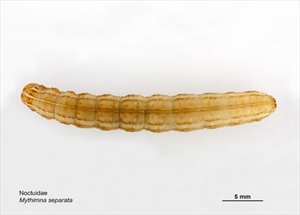- Widespread distribution. On rice and many other cereals, vegetables, food legumes, grass weeds. Important moth, more so on dryland than irrigated rice.
- Damage: i) rice - panicles cut at base at grain filling; ii) maize - young plants destroyed; mature leaves eaten (larvae in axils).
- Eggs laid in rows along leaf blades; young larvae "loop"; mature larvae, up to 40 mm long, with narrow, yellowish-white stripe along the back and two others at the sides; nocturnal.
- Spread: late stage larvae swarm together as "armyworms"; adult (moth) migratory.
- Natural enemies: spiders eat early instars; parasitoids (Cortesia wasp, tachnid fly).
- Cultural control: avoid rice after maize; weed; ducks; perches for insect-feeding birds; adjust water levels to drown larvae; burn or bury stubble after harvest.
- Chemical control: dryland crops before larvae mature: i) collect diseased larvae, macerate and spray; ii) synthetic pyrethroids, but they will kill natural enemies.








